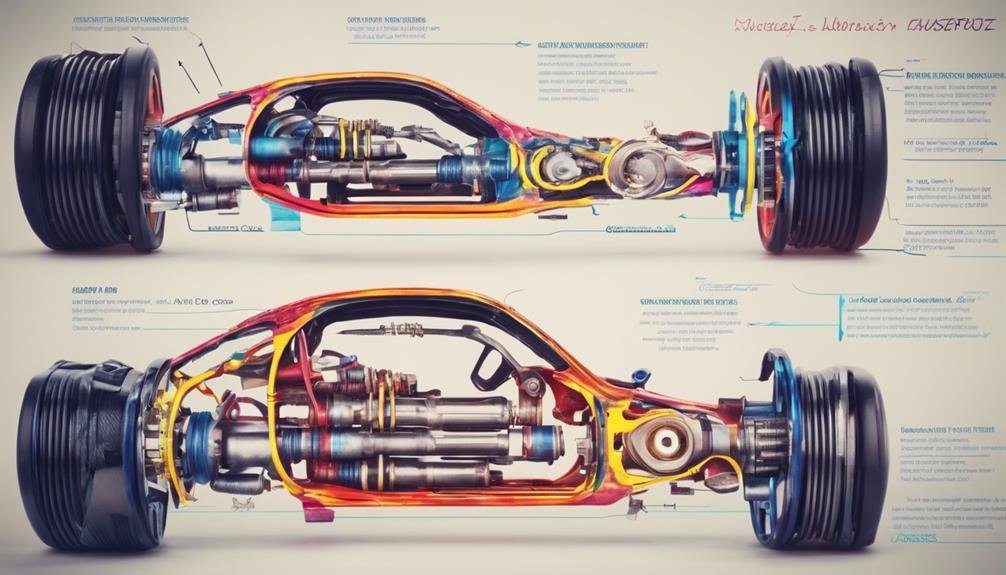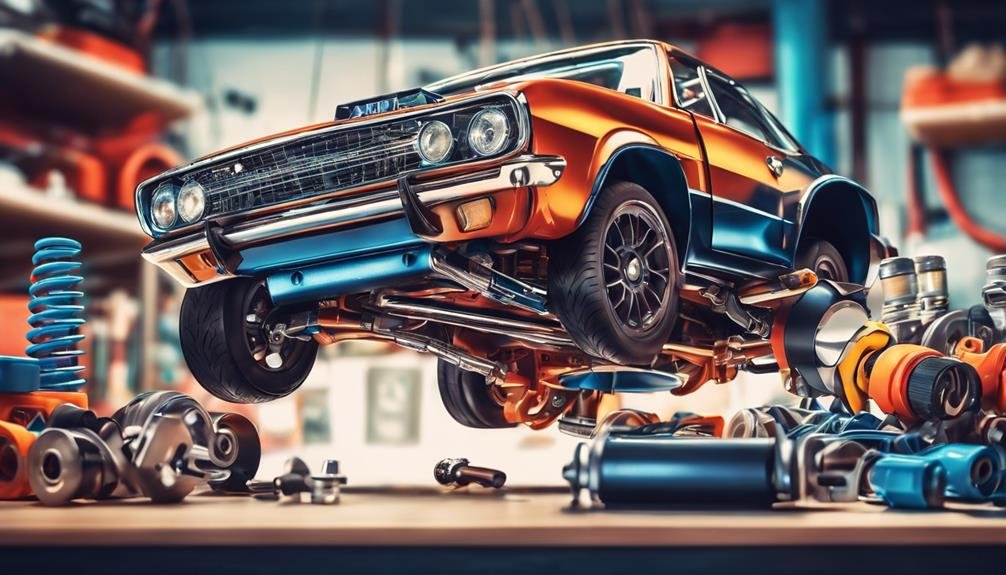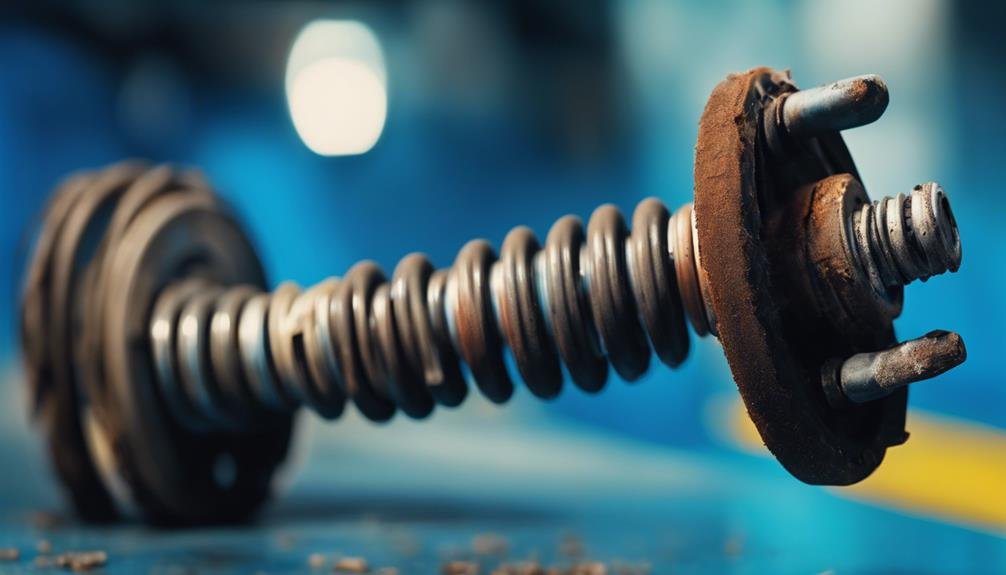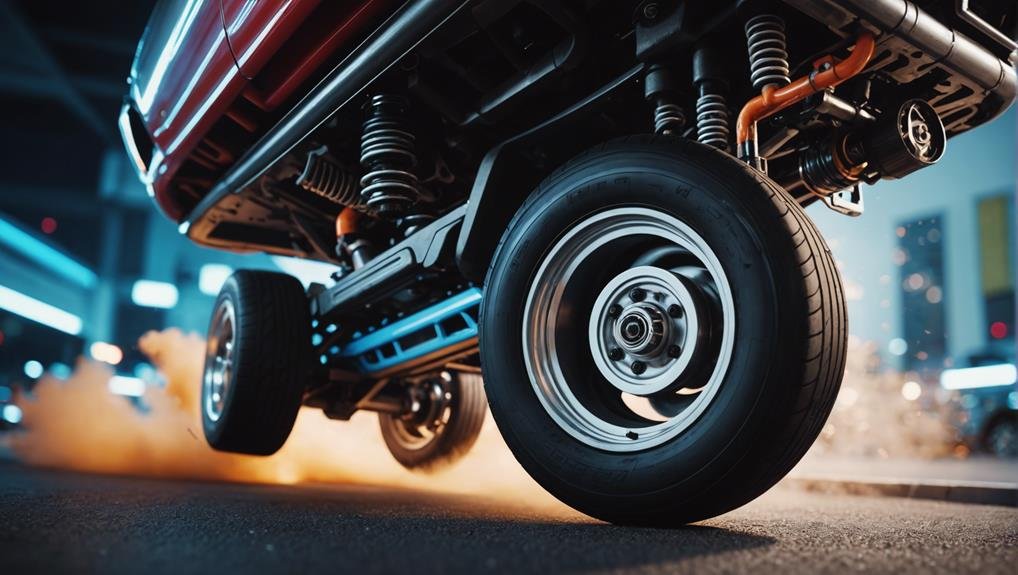As you drive, your car's suspension system works to absorb bumps, stabilize the vehicle, and provide a smooth ride. It's a complex system comprising springs, shock absorbers, control arms, sway bars, and struts. Springs store energy from bumps, shock absorbers control energy release, and control arms maintain wheel alignment. Sway bars reduce body roll, while struts provide structural support and damping functions. The suspension system guarantees a safe and stable driving experience. Now that you've got a glimpse into how car suspension works, you'll want to delve further to understand the intricacies of this critical system.
Key Takeaways
- The suspension system absorbs shocks and bumps, ensuring a smooth ride and stable handling.
- Springs store energy from bumps, while shock absorbers control the release of that energy.
- Control arms and sway bars work together to maintain wheel alignment and reduce body roll during cornering.
- The type of suspension system used depends on vehicle design, driving conditions, and desired performance characteristics.
- Regular maintenance is crucial to prevent premature wear, ensure peak performance, and maintain safety on the road.
Car Suspension Basics
As you drive, your car's suspension system kicks in to absorb shocks, maintain tire contact, and improve stability, making it an important component of your vehicle's complete performance.
The main components of this system, including springs, shock absorbers, control arms, sway bars, and struts, work together to provide a smooth ride and stable handling.
Springs store energy from bumps and road imperfections, while shock absorbers control the release of that energy, making sure your car maintains contact with the road.
Meanwhile, control arms and sway bars help to stabilize the vehicle, allowing you to corner with confidence.
Struts, a combination of springs and shock absorbers, also play a critical role in cushioning the cabin from road imperfections, providing a more comfortable ride.
By absorbing shocks, maintaining tire contact, and improving stability, your car's suspension system helps to guarantee safe driving, stable handling, and an enjoyable driving experience.
With its important components working in harmony, the suspension system is necessary for a safe and enjoyable driving experience.
Types of Car Suspension
Now that you comprehend the fundamentals of your car's suspension system, it's time to explore the different types that can impact your driving experience.
There are two primary categories of car suspensions: independent and dependent. Independent suspension types, such as MacPherson Strut, Double Wishbone, and Multi-Link Suspension, allow each wheel to move separately, enhancing handling and overall vehicle dynamics.
On the other hand, dependent suspension types, including Leaf Springs, Satchell Link, and Panhard Rod, connect wheels rigidly, affecting ride comfort and stability. The choice of suspension type depends on the vehicle's design, intended use, and desired performance characteristics.
Independent suspensions typically provide better handling and ride comfort, while dependent suspensions often prioritize stability and load-carrying capacity. Understanding the differences between these types of car suspensions can help you make informed decisions when purchasing or modifying a vehicle.
Main Suspension Components

You'll find five critical components working together to form your car's suspension system. These components are the backbone of how car suspension works, ensuring a smooth ride and stable handling.
The initial component is springs, which store and release energy from road impacts.
Next, shock absorbers control the movement of these springs, dampening vibrations and maintaining stability.
Control arms connect the suspension system to the vehicle's frame, allowing for wheel movement and flexibility.
Sway bars, also known as anti-roll bars, connect suspension components to reduce body roll and improve handling.
To conclude, struts provide structural support and damping functions in certain suspension designs. These components work in harmony to absorb shocks, maintain stability, and provide a comfortable ride.
How Suspension Works Together
When you're driving, the suspension components work in unison, with each part playing a crucial role in maintaining a smooth ride and stable handling. The collaboration of these components guarantees that your vehicle can absorb bumps, maintain tire contact with the road, and provide a comfortable driving experience.
Here's how the suspension components work together:
- Springs store and release energy, absorbing bumps and road imperfections.
- Shock absorbers control the energy released by the springs, providing a smooth ride.
- Control arms connect the suspension components to the chassis, maintaining wheel alignment and stability.
- Sway bars reduce body roll during cornering, enhancing handling and stability.
- The suspension system works harmoniously to absorb external forces, maintain tire-road contact, and minimize body movements, resulting in a safe, controlled, and stable driving experience.
Importance of Regular Maintenance

Regular upkeep of your car's suspension is important to prevent premature wear and tear on its components, ensuring peak performance, handling, and safety. By prioritizing regular maintenance, you'll extend the lifespan of your suspension components, which in turn, will improve your driving experience.
Timely inspections can identify issues early, preventing costly repairs down the line. Neglecting suspension maintenance can lead to decreased ride comfort, poor handling, and compromised safety.
Incorporating regular maintenance into your car care routine is vital to maintaining top performance. This includes checking and replacing worn-out parts, ensuring proper lubrication, and making adjustments as needed. By doing so, you'll enjoy a smoother ride, better handling, and improved safety on the road.
Common Suspension Problems
As you drive, do you feel every bump and jolt, or notice your car bouncing excessively on the road, signaling potential issues with your suspension system? If so, you're not alone. Common suspension problems can make for a rough ride, and if left unchecked, can compromise your safety on the road.
Some common signs of suspension issues include:
- Feeling every bump and jolt due to a worn-out suspension
- Bouncing excessively on the road, making for a rough ride
- Pulling to one side when cornering, causing uneven tire tread wear
- Nose-diving when braking, rolling or squatting during acceleration, and experiencing steering wheel vibrations
- A failed bounce test, which can indicate worn-out suspension components
It's crucial to address these issues promptly to maintain safe and comfortable driving conditions. Ignoring suspension problems can lead to more severe consequences down the road.
Suspension Wear and Tear Signs

Suspension wear and tear often reveals itself through telltale signs that you can spot while driving or observing your vehicle. If you notice your car pulling to one side while driving, it may be a sign of suspension issues. Likewise, if your vehicle is sitting lower on one corner or side, it could indicate worn-out suspension components. Another indicator is an increased bumpiness or rough ride, which can be uncomfortable and signal potential suspension problems.
| Signs of Suspension Issues | Description | What to Do |
|---|---|---|
| Car pulling to one side | Uneven tire wear, difficulty steering | Check suspension components, alignments |
| Vehicle sitting lower | Worn-out springs, struts, or shocks | Inspect and replace worn parts |
| Increased bumpiness | Worn-out shocks, struts, or springs | Check and replace worn parts |
| Clunking noises or rattling sounds | Worn-out mounts, bushings, or ball joints | Inspect and replace worn parts |
| Steering wheel vibrations or shaking | Worn-out mounts, bushings, or ball joints | Inspect and replace worn parts |
Choosing the Right Suspension
When selecting the appropriate suspension for your vehicle, you'll need to keep in mind factors like your driving style, budget, and the type of vehicle you own. This will help you determine which suspension type best fits your needs.
Different suspension types offer varying levels of comfort, performance, and handling characteristics, so it's crucial to think about what matters most to you.
Here are some key considerations to bear in mind:
- Adjustable suspensions allow customization for specific driving conditions or preferences
- Upgraded suspension systems can improve the overall driving experience and vehicle performance
- Professional consultation or research can assist in selecting the most suitable suspension setup for your needs
- Comfort, performance, and handling characteristics vary across different suspension types
- Your budget will play a significant role in determining the type of suspension you can afford
Frequently Asked Questions
How Does the Suspension of a Car Work?
As you drive, your car's suspension works to absorb shocks, maintain tire contact, and improve stability, allowing wheels to move independently and adapting to road conditions, ensuring a smooth, comfortable, and safe ride.
What Is the Basic Operation of the Suspension System?
You experience a smooth ride because your car's suspension system absorbs shocks and vibrations, maintaining tire contact with the road, while springs store and release energy, and shock absorbers control motion, ensuring stability and control.
What Are the Six Basic Functions of the Suspension System?
You're about to learn the six crucial functions of the suspension system, which include maintaining stability, enhancing handling, providing a comfortable ride, preventing loss of tire-road contact, absorbing external forces, and ensuring stable handling and driving comfort.
What Are 3 Main Parts of a Suspension System?
You're wondering what makes your ride smooth and stable. The three main parts of a suspension system are springs, shock absorbers, and control arms, working together to absorb shocks and improve handling.
Conclusion
Now that you've grasped the basics of car suspension, you're better equipped to appreciate the engineering behind it. By understanding how the different components work together to absorb shocks, you'll be more aware of your vehicle's needs.
Regular maintenance and inspections will help prevent common issues, ensuring a smoother ride and safer driving experience. Keep an eye out for signs of wear and tear, and choose the right suspension for your vehicle's specific needs.
